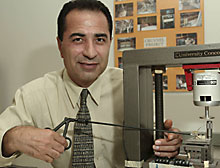Sense of touch reproduced in endoscopic surgery: New professor Javad Dargahi puts micro machining on medical frontier

Javad Dargahi is working on a device that would re-create the feeling of force surgeons need to have when operating.
Photo by Andrew Dobrowolskj
A good surgeon’s hands are not only steady, they can feel subtle differences in biological tissues to detect the presence of disease or blood vessels, for example.
However, surgeons don’t even touch tissues when they use increasingly common minimally invasive surgery techniques. They simply insert endoscopes — long, thin handles equipped with tiny cameras and grasping and cutting tools — into the body through small incisions.
Javad Dargahi, an assistant professor of mechanical and industrial engineering at Concordia, is developing a device that would replicate the hand’s sensory capabilities in endoscopic surgery.
“With his hand, the surgeon can measure the force he exerts, and the position of the exerted force,” Dargahi said in an interview. “He also measures the softness, hardness, temperature, and texture of the tissue. All that is missing in endoscopic surgery. The idea is to design an electromechanical sensor to do this, and integrate it with the grasping tool.”
Dargahi has been interested in robotic tactile sensing for a long time, and completed his PhD thesis in this field 10 years ago. A native of Iran, he did all his university studies in the United Kingdom, then returned to Tehran to teach. He went to Simon Fraser University to do postdoctoral work on micro-machining techniques in 1997, then worked for private industry and at the University of New Brunswick. He came to Concordia in September 2001.
He has already designed and fabricated two prototypes, and has just received a $35,000 grant from Precarn Incorporated and the Institute for Robotic and Intelligent Systems (IRIS) to work on the third generation of the device.
Precarn is a Canadian consortium of corporations, research institutes and government partners in the intelligent systems industry. It manages IRIS, a Network of Centres of Excellence that focuses on the essential elements of intelligent systems — the ability to perceive, reason and act.
With this generation of the device, Dargahi plans to fabricate a miniaturized prototype, using micro-machining techniques, and to integrate the sensor into the endoscope. The sensor will be encapsulated, or insulated, so it won’t be damaged by body fluids, and won’t produce any side effects on the patient.
Since the device will be micro-machined (a technique used to fabricate MEMS, or micro-electro-mechanical systems), it can be produced cost-effectively in large batches. It will be disposable. Micro-machining also means the device can be made in different sizes for use on different body organs.
Dargahi expects the sensor to be able to measure force, position of the applied force, and softness of the tissue. In his research, he has been able to measure the softness of human fingers. Eventually, he intends to test the device on samples of other types of tissues, such as samples of prostate glands. Tissue softness is an important factor in surgery since some malignant tumours, for example, are harder than the surrounding healthy tissues.
From the surgical standpoint, Dargahi has been collaborating for several years with a colleague at the St. John Regional Hospital in New Brunswick. He has also recently begun to make contacts with individuals in Montreal’s medical community.
Once this prototype of the device has been designed, fabricated and tested, he hopes it will eventually become commercially available. He said researchers in many other large universities are also working in the field of tactile sensors. These devices promise to have many applications, especially when combined with robotic devices.
Dargahi said he is taking a different avenue from his competitors in the design of the sensor, and he feels that the way the device is integrated in the endoscope is unique.